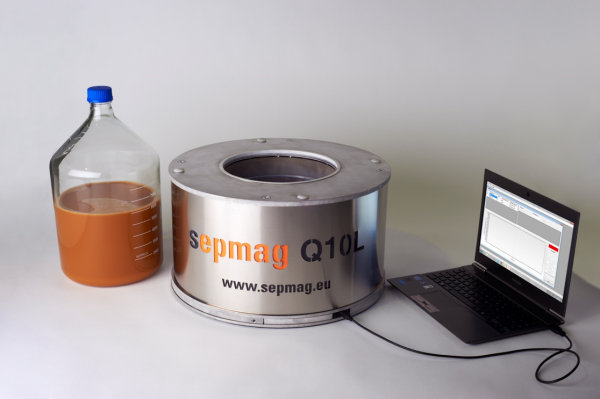Although separation time may be one of the most obvious parameters to validate in your magnetic separation rack production, it is certainly not the most critical. Classical magnetic separation rack use non-homogeneous magnetic separation. When scaling up production on these devices, larger volumes can lead to longer and longer separation times.
This post is about biomagnetic separation with a magnetic separation rack, and how to scale-up this process. If you are interested in this topic, download our free ebook The Basic Guide to Scale-up Biomagnetic Separation Processes:
Keeping separation time constant
The way to keep separation times constant in classical systems is by increasing the magnetic force on the beads farthest from the magnets. But increasing the force on these distant beads will necessitate increasing the force by a great deal in the retention zone. Magnetic beads in the retention zone exposed to such great forces over time will irreversibly aggregate, causing a great deal of difficulty in the final separation.
It is very difficult to balance time of separation and strength of magnetic force so that you have a yield that is comparable to smaller production volumes.
In order to easily move from one volume to another in biomagnetic separation processes, it is imperative to have well-defined conditions for the separation. Homogeneous biomagnetic separation systems such as SEPMAG allow the magnetic force to remain constant throughout the entire volume of the device. If the magnetic force is well defined, it is easy to scale up production because the parameters do not need to be changed.
Defining the ideal magnetic force
A well-defined magnetic force is a force that is high enough for the beads to be magnetically saturated, but low enough that irreversibly aggregated beads do not form. The force must also be high enough to retain the beads during supernatant removal. With the optimal magnetic forces known for various volumes, the only parameter that needs to be determined in the new volume is the correct time of separation. The separation time for larger systems can be estimated as:
tlarge volume=tsmall volume*(Rlarge volume*Flarge volume)/(Rsmall volume*Fsmall volume)
where R is the distance travelled by the farthest beads and F the magnetic force of the device. The magnetic bead separation speed is constant and is proportional to the magnetic force. Therefore, the separation time is only dependent on the distance travelled by the beads to the retention area (usually the vessel radius).
Unlike classical systems, SEPMAG’s homogeneous magnetic separation systems can easily monitor homogeneous magnetic bead separation conditions by using built-in optical sensors, further simplifying the validation and quality control process. By making sure that all parameters are well-defined, scaling up using homogeneous systems becomes a much easier task performed at a fraction of the cost.
Don't forget to check these posts from our blog in order to get a deeper insight into the scaling-up of biomagnetic separation processes:
- Scaling Biomagnetic Separation Process avoiding irreversible aggregation problems
- Permanent magnets vs. Electromagnets: considerations for scaling up magnetic beads separation processes
- How to Avoid Safety issues when scaling up Biomagnetic Separation Process
Check www.sepmag.eu/ebooks to access to FREE eBooks on the subject, or contact us. We will be glad to help you to achieve an efficient magnetic bead separation process!





